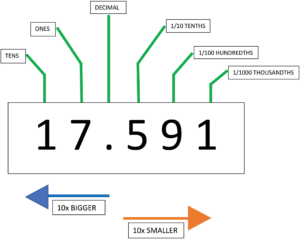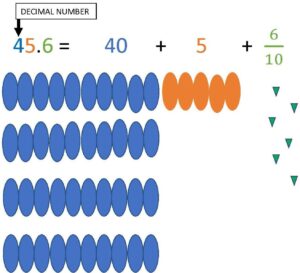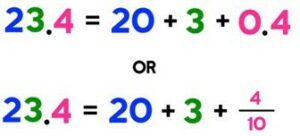11 Understanding Decimals
Understanding Decimals
A decimal is a number that consists of a whole and a part of a whole. Decimal numbers lie between integers and represent numerical value for quantities that are whole plus some part of a whole.

This should be read as 17 and 591 thousandths.
How to read the decimal properly: we read decimal numbers by their
decimal position.
Example 1: “forty-five and six-tenths” written as a decimal number:
The decimal point goes between Ones and Tenths.
45.6 has 4 Tens, 5 Ones and
6 Tenths, like this chart to the right:

Example 2: What is 2.3 ?
On the left side is “2”, that is the whole number part.
The 3 is in the “tenths” position, meaning “3 tenths”, or 3/10
So, 2.3 is “2 and 3 tenths”
Example 3: What is 13.76 ?
On the left side is “13”, that is the whole number part.
There are two digits on the right side, the 7 is in the “tenths” position, and the
6 is the “hundredths” position.
So, 13.76 is read as 13 and 76 hundredths.
A Decimal Fraction is a fraction where the denominator (the bottom number) is to the power of 10, for example:10, 100, 1000, etc
So, 2.3 Looks like 23/10 And, 13.76 Looks like 1376/100
To convert a decimal to a fraction, place the decimal number over its place value. For example, in 0.6, the six is in the tenths place, so we place 6 over 10 to create the equivalent fraction, 6/10.

More Examples:
5/10 = 0.5 2/100 = 0.02 16/1000 = 0.016
1/100 = 0.01 195/10000 = 0.0195 45/10 = 4.5
*See further explanation of the power of ten in the Electrical section of this book.

